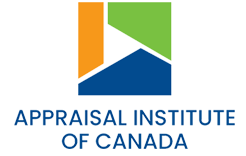APPRAISAL PROCESS
AIC Designated Members provide unbiased real property appraisal, review, consulting, reserve fund planning, machinery and equipment, and mass appraisal valuations. Their comprehensive research and analysis provide critical market value opinions to property owners, businesses, investors, governments, and professionals for real property portfolio planning and transactions.
AIC offers two professional designations – Accredited Appraiser Canadian Institute (AACI™) and Canadian Residential Appraiser (CRA™). AACI™ can perform any appraisal and consulting assignment on all types of properties, while CRA™ can handle appraisal and consulting work on residential dwellings with four self-contained family housing units or on undeveloped residential dwelling sites.
Both designations guarantee high quality, professionalism, and knowledge, and are recognized as experts in legal settings. AIC Designated Members complete a Program of Professional Study that includes university-based education with the University of British Columbia and Université Laval. They must also pass an applied experience program and exam, professional competency interview, and hold a degree from a recognized Canadian university to become AACI™ or CRA™ designated.


Involvement Of AIC Designated Appraiser In Real Estate Decisions
An AIC-designated appraiser is engaged when a property owner needs an expert, unbiased opinion on the value of real estate to make a well-informed decision about real estate. They are involved in:
- Renovating or building Buying or selling property
- Financing or refinancing property
- Making real estate investment decisions
- Reviewing property tax assessments
- Assessing capital gains
- Making a claim for insurance purposes
- Determining or facing expropriation compensation
- Valuing property for matrimonial purposes, arbitration or other litigious matters
- Business mergers, acquisitions or dissolutions involving real estate
- Reporting on property values to meet International Financial Reporting Standards (IFRS)
- Completing reserve fund studies or depreciation reports for condominium/strata property
Properties Appraisable By AIC Designated Members
AIC-designated appraisers can provide valuation services on all types of properties, including:
- Residential—single-family homes, multi-units, recreational, heritage, etc.
- Commercial—office buildings, retail, hotels, storage facilities and other income-based properties
- Industrial—manufacturing, machine shops, etc.
- Institutional—hospitals, schools, churches, publicly-owned property, etc.
- Mining/resource-based—oil and gas, timberland, sand pits, pulp and paper, etc.
- Rural—agricultural, land, winery, orchards, etc.
- Special uses—airports, golf courses, contaminated property, harbor, military facilities, prisons, etc.
- Personal property—furniture, tools, tanks, technology, automotive, aircraft, motors, etc.


Services Provided By AIC Designated Appraisers
Many AIC-designated appraisers offer specialized real estate knowledge, such as:
- Arbitration and negotiation
- Expert testimony and litigation support
- Cost-benefit analysis
- Feasibility studies
- Foreclosure
- Highest and best use
- Insurance and replacement cost
- Relocation valuation
- Market analysis and market rent studies
- Reserve fund studies
- Asset/portfolio management
- Right of way, easement, partial takings
- Tax assessment appeals
- First Nation land claims
- Machinery and equipment valuation
- Green/Solar
Appraisal Methodologies
Several methodologies are used by AIC-designated appraisers, depending on the scope of the assignment and the property type.
- Direct Comparison Approach: a methodology whereby the appraiser develops an opinion of value by analyzing completed sales, listings or pending sales of properties that are similar to the subject property.
- Cost Approach: a methodology that considers the land and building components separately and reaches a value conclusion by adding these estimates together. Like the Direct Comparison Approach, the Cost Approach is based on a comparison of the cost to replace the subject (cost new) or the cost to reproduce the subject (substitute property). The cost is reduced by the accrued depreciation (i.e. physical wear and tear, functional deficiencies and external influences) of the dwelling and the site improvements (i.e. garage, deck, pool, etc.). The Cost Approach is more reliable when a property is newer due to the lower depreciation.
- Income Approach: a methodology that is used to determine the valuations of income-producing properties. Typically purchased as investments, the earning potential is an important element affecting the value of these properties. Through the Income Approach, the appraiser analyzes a property’s revenue and expenses to convert the income into a present value. This methodology is typically not applied when valuing a residential property.


Appraisal Reports Type
AIC-designated appraisers assess the type of property being appraised and the complexity, nature and scope of the assignment when determining the type of report to complete for their clients. Three types of reports are generally used:
- Form reports: are more commonly used for completing appraisal reports on residential properties.
- Short narrative reports: are used to provide concise information and set out the key salient facts and conclusions of an assignment.
- Full narrative reports: are used when a client needs greater detail, research and conclusions
Appraisal Process
The Appraisal process and procedures vary according to the type of property, the requirements of the client, and the applicable methodology for each appraisal assignment. However, in general, the preparation of an appraisal report encompasses the necessary research and analysis in accordance with the Canadian Uniform Standards of Professional Appraisal Practice, which may involve the following:
- Identification of the subject property and intended use of the appraisal report
- Determination of the type of appraisal report (Current, Retrospective, Prospective, and Up-Date) and its effective date
- Inspection of the subject property and surrounding area
- Review and analysis of data pertaining to the subject property. This may include the rent roll, operating statements, Tax Bill, review of the leases in place, floor plan, etc
- Analysis of land use controls pertaining to the subject property
- Analysis of the subject property’s general/specific location and influencing characteristics of the subject’s location on its market value
- Analysis of market condition and general/specific economic forces on the value of the subject property
- An in-depth discussion, determination, and statement of Highest and Best Use
- A discussion of the appraisal methodologies and procedures employed in arriving at indications of value
- Search for, and analyses of, sales and listings of “index” or “comparable” properties that might reasonably be used to indicate a value for the subject property
- Compilation and analysis of the data and reconciliation thereof into an estimate of market value as of the effective date of the appraisal



